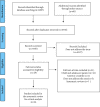Evaluation of Electromyographic Activity of Masticatory Muscles in Adults with Posterior Crossbite
- PMID: 35313630
- PMCID: PMC8934209
- DOI: 10.1155/2022/4552674
Evaluation of Electromyographic Activity of Masticatory Muscles in Adults with Posterior Crossbite
Abstract
Introduction: There is evidence that patients with posterior crossbite (PXB) have neuromuscular changes in the masticatory muscles. However, up to the present time, the relationship among these changes on the electromyographic activity of the masticatory muscles is still unclear.
Objective: To systematic review the available literature on the electromyographic activity of masticatory muscles in adults with PXB.
Methods: Between August 22 and September 9, 2020, we searched the following seven electronic databases: PubMed, EMBASE, Web of Science, Cochrane Library, SciELO, LILACS, and Scopus. No restrictions were applied regarding the language and year of publication. This systematic review was registered in the Prospective Register of Systematic Reviews (PROSPERO - CRD42020205057) database and conducted using the Preferred Reporting Items for Systematic Reviews and Meta-Analysis (PRISMA) guidelines. After data selection and extraction, the methodological quality of the selected studies was conducted independently by two reviewers, using two different evaluation tools.
Results: 6957 records were initially located after the search process. In the end, eight papers were selected. Most studies were classified as having average to low methodological quality and moderate to high risk of bias. Based on the available evidence, adult patients with PXB have electromyographic activity changes in the masticatory muscles when compared with individuals without PXB. Moreover, adult patients with unilateral posterior crossbite (UPXB) have asymmetrical electromyographic activity when the crossbite side is compared with the noncrossbite side.
Conclusion: Despite the lack of studies with high methodological quality, electromyographic evaluation of masticatory muscles should be considered in the diagnosis and in the orthodontic treatment plan of patients with PXB. Prospective studies with a higher sample size and follow-up time, conducted using a rigorous scientific methodology, are necessary to reach a more reliable conclusion.
Copyright © 2022 Luiz Makito Osawa Gutierrez et al.
Conflict of interest statement
The authors declare that there are no conflicts of interest.
Figures
Similar articles
-
Exploring the potential of rapid maxillary expansion and masticatory muscle activity in unilateral posterior crossbite.J Clin Exp Dent. 2024 Jun 1;16(6):e755-e771. doi: 10.4317/jced.61604. eCollection 2024 Jun. J Clin Exp Dent. 2024. PMID: 39183996 Free PMC article. Review.
-
Effect of unilateral posterior crossbite on the electromyographic activity of human masticatory muscles.Am J Orthod Dentofacial Orthop. 2000 Sep;118(3):328-34. doi: 10.1067/mod.2000.103252. Am J Orthod Dentofacial Orthop. 2000. PMID: 10982935
-
Orthodontic intervention combined with myofunctional therapy increases electromyographic activity of masticatory muscles in patients with skeletal unilateral posterior crossbite.Acta Odontol Scand. 2014 May;72(4):298-303. doi: 10.3109/00016357.2013.824606. Epub 2013 Nov 21. Acta Odontol Scand. 2014. PMID: 24255961
-
Beyond the black stump: rapid reviews of health research issues affecting regional, rural and remote Australia.Med J Aust. 2020 Dec;213 Suppl 11:S3-S32.e1. doi: 10.5694/mja2.50881. Med J Aust. 2020. PMID: 33314144
-
Evaluation of the Changes of the Intercanine and Intermolar Widths Following Palatal Expansion in the Mixed Dentition Patients with Bilateral Posterior Crossbite: A Systematic Review.Dent J (Basel). 2023 Feb 13;11(2):52. doi: 10.3390/dj11020052. Dent J (Basel). 2023. PMID: 36826197 Free PMC article. Review.
Cited by
-
Clinical and electromyographic signals analysis about the effect of space-adjustment splint on overerupted maxillary molars.BMC Oral Health. 2024 Mar 2;24(1):296. doi: 10.1186/s12903-024-04039-6. BMC Oral Health. 2024. PMID: 38431564 Free PMC article.
-
Exploring the potential of rapid maxillary expansion and masticatory muscle activity in unilateral posterior crossbite.J Clin Exp Dent. 2024 Jun 1;16(6):e755-e771. doi: 10.4317/jced.61604. eCollection 2024 Jun. J Clin Exp Dent. 2024. PMID: 39183996 Free PMC article. Review.
References
-
- Bell R. A., Kiebach T. J. Posterior crossbites in children: developmental-based diagnosis and implications to normative growth patterns. Seminars in Orthodontics . 2014;20(2):77–113. doi: 10.1053/j.sodo.2014.04.002. - DOI


